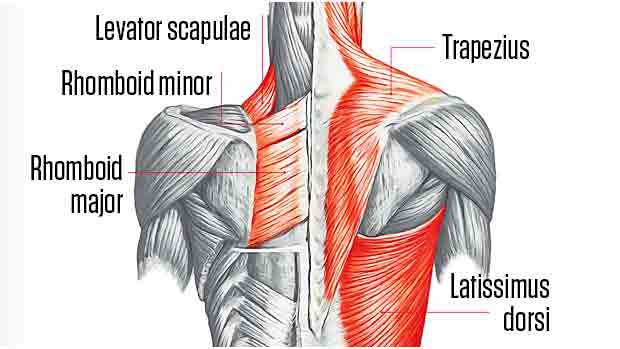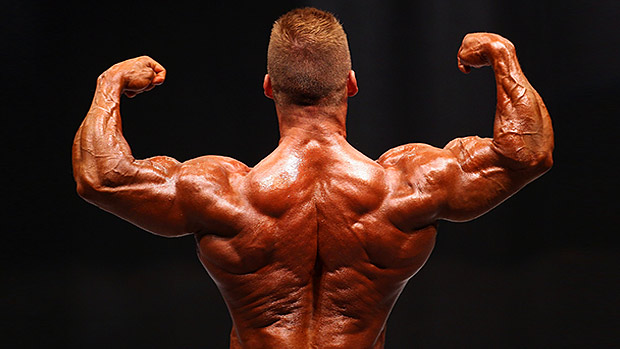Building a big back takes a willingness to work hard, lift heavy, and train smart. Most lifters have the hard work and heavy lifting parts down. But to get full development – that chiseled topographical map of muscles – you need to train smarter.
Simply hammering rows and pulldowns from the same angles every back workout isn't going to cut it. You'll see some positive changes, but you won't maximize your potential. To do that, you'll need to:
- Know what muscles you want to hit.
- Know what angles work what muscles.
- Know what exercises hit those angles.
- Know how to program those exercises.
So first let's cover the movement patterns and exercises (the fun stuff), then we'll look at programming, and finally we'll geek out and break down the anatomy.
By setting up the cable unit at your feet and pulling towards your chest as you're hinged forward (and then pulling over your forehead as you stand up) you'll create an upward motion that allows you to load up heavy. Use a wider neutral grip bar to maximize your retraction capability while also allowing for a great stretch of the lats after each eccentric (negative) rep.
You'll hit the lats, mid and lower traps, rhomboids, and posterior deltoids (and thus teres major).
Check your form:
- Use a strong stance with feet driving into the ground.
- Use a proper hinge that loads the glutes and puts a small stretch on the hamstrings.
- Brace your core by engaging your midsection like you're preparing to take a punch.
- Take a small step away from cable anchor to avoid slamming the weights back into the stack on each rep. This also allows you to go into a bit of an eccentric loaded stretch during each rep.
- Use a neutral grip with an emphasis on driving the elbows behind and "around" the back.
- Use a controlled eccentric/lowering phase with a small protraction reach at the end of each rep.
This exercise is called an overhead banded face pull. The face pull doesn't get as much love from hardcore lifters because you aren't able to load it up like you can other back movements. This lift significantly limits the amount of weight you can handle at the end range.
This will hit the external rotators, the posterior delts, the middle and upper traps, and a bit of your lats.
Check your form:
- Use a strong stance with feet driving into the ground.
- Lean back slightly into your hips with a tall spine.
- Brace your core to resist the bands desire to pull you over.
- Pull your arms towards your eyes, elbows wide, until you reach ideal depth.
- Rotate your fists behind you as though you're making a "field goal is good" hand motion.
- Hold this top squeeze for a two-second count and slowly release back to the start.
While it may seem sort of contradictory to have an isometric contraction on this list, our muscles don't need to create movement in order to be worked, become exhausted, and require recovery that can lead to hypertrophy.
In fact, isometrics done in the right way can actually help enhance our growth potential by targeting specific ranges of motion, and thus muscle fibers, that are weaker or underdeveloped.
Anything like a farmer's carry, a deadlift, or even an isometric row hold will do wonders hit the outer lats, the rhomboids, posterior delts, and traps.
Technically you could accomplish this doing the snatch-grip trap bar deadlift, which was something I learned from Dr. Joel Seedman here.
Or try my personal favorite carry variation – the cowboy carry:
Your execution on both emphasizes the lat squeeze caused by actively depressing and downwardly rotating the scapula. As Tony Gentilcore has said, "imagine squeezing an orange in your armpits and making orange juice."
All rowing variations are horizontal in relation to your torso, and I like the one-arm row because it allows you to pull in a J-shape manner.
While the one-arm row is a classic move in most programs, it can usually be done better by pulling with this J-shaped trajectory. One concept in muscular anatomy that's often overlooked is the direction that fibers run.
Muscles contract along the lines of fibers within them. So, muscles only contract in the direction those fibers run. In the case of the lats, the fibers run a bit diagonally from the shoulder joint down towards the lumbar spine. So it's important to use those fibers that are high up in the back (and diving into the shoulder joint) by letting a weight travel in front of us during rows.
This adjustment has been making a huge difference for my clients for years, and Lee Boyce has touched on it too.
Check your form:
- Get one knee on a bench with the same-side arm directly underneath the shoulder joint.
- Your off-bench leg should shoot out wide to "get out of the way" and create a pocket for the elbow.
- Engage your core and brace to keep your spine level (tabletop back).
- Let the dumbbell begin underneath your forehead/eye region and pull it towards your hip.
- Move it back towards the hips, up towards the ceiling, and then in towards the spine.
- Slowly control the weight back into that stretched lat position.
Lat pulldowns (vertical pulls) have always been a staple, but the variation here is special because it's unilateral (one side at a time) and it allows for an intense stretch of the lats as the scapula upwardly rotate and move into elevation.
This angled single-arm pulldown allows for a tremendous eccentric stretch as well as a powerful contraction as you move your shoulders into adduction and add external rotation and depression of the scapula.
Check your form:
- Lean against a bench with a 45-60 degree incline. Reach and grab a cable with a neutral grip.
- Brace your core and push into bench for leverage as the elbow drives down into the rib cage.
- Actively rotate the hand from neutral grip to a pronated one as you finish the rep.
- Control the eccentric portion and allow for a stretch at the top of the movement.
The face-down (prone) position, especially when used at a 45-degree angle with a bench, allows for you to hit your back with a variety of exercises without getting up. This chest-supported position also allows you to load up because you can drive into the bench for leverage. The key, though, is to keep your thoracic spine in some level of extension. You don't want to slouch over the bench. Keep your chest up.
Tempo is also key. Don't rush these three exercises. Take your time and experience greater time under tension to truly fatigue the muscle fibers.
45-Degree Chest-Supported Row
45-Degree Chest-Supported Shrug
45-Degree Chest-Supported T and Y Raise
The back can handle an exceptional amount of volume and frequency when compared to other groups, such as the pecs. Sure, you don't want to train them every day, but you can certainly hit them more frequently than the standard once or twice a week that many recommend.
Back training goes with everything too. The muscles are involved in all your other training modalities from squatting, pressing, deadlifting, and even sprinting. There isn't a "bad" day to do back training.
A weekly program can look like this:
- Day 1: Hinge, Glutes, Hamstrings, and Back
- Day 2: Recovery Cardio and Core
- Day 3: Chest and Back
- Day 4: Quads, Hams, Calves
- Day 5: Shoulders and Back
- Day 6: Movement Quality and Cardio
- Day 7: Day Off
You'll notice that back work is scheduled on three days of the week:
On the first day, the back work is complimentary to the hinge and lower body work (roughly 6 to 10 sets).
On the third day, go for an antagonist style workout that has you alternating between chest and back (15 to 20 sets).
On the fifth day, go all-out on back after fatiguing shoulders (roughly 20-25 sets).
In a four-week cycle this leads to 12 workouts that attack the back. That's more than enough to stimulate growth in even the most stubborn of bodies.

The back of your body is so much more than your lats, traps, and spinal erectors. Sure, these big movers are the super visible muscles in developed bodybuilders and powerlifters, but they aren't the whole picture.
The lats (latissimus dorsi)
They drive shoulder extension and adduction, which contributes to scapular retraction, depression, and downward rotation – all necessary skeletal movements to make the most of your vertical and horizontal pulls.
The traps (trapezius)
It has a variety of functions...
- The upper traps work with the levator scapulae to elevate the scapula (such as shrugs).
- The middle traps contribute to elevation but also begin working on some level of retraction.
- The lower traps contribute to retraction and play a role in upwardly and downwardly rotating the scapula (such as with pull-ups or pulldowns).
The spinal erectors (erector spinae)
They isometrically contract to stabilize the lumbar and lower thoracic spine in all major movements. Combined with the quadratus lumborum they also contribute to lumbar rotation and lateral flexion of the spine – key for sports and rotational training.
We must also consider other muscles in the area, big and small:
- The rhomboids: They run vertically along the spine, but their fibers run sideways, making them excellent at retraction for the scapula.
- The levator scapulae: They help elevate the scapula, which is important in movements such as shrugs and low-to-high-pulls.
- The posterior deltoids: They function predominantly at the shoulder joint by driving shoulder extension but can aid in retraction and depression of the scapula. This head of the delt muscle, when developed, improves the performance capacity and aesthetics simultaneously.
- The teres major: They work with the posterior delts to drive adduction and shoulder extension – key for full retracting and depressing the scapula in vertical, or high-to-low rowing motions.
- The infraspinatus and teres minor: These are critical rotator cuff muscles. They externally rotate the humerus in the shoulder joint. Developing the capacity of these muscles contributes to your output on vertical pulling patterns (in a pronated hand position), wide grip rows, and various face pull exercises.
Hit all the angles covered above and you'll nail every part of your back.





